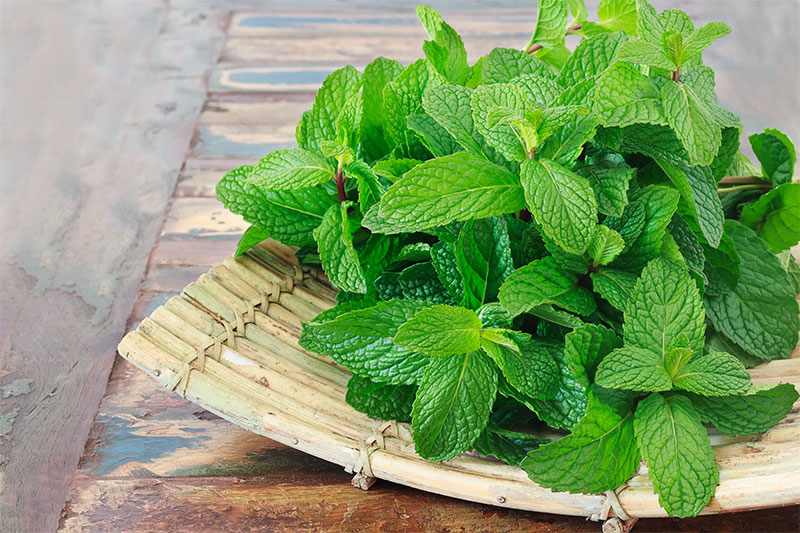Mint is a common ingredient in many kinds of toothpaste, gums and well mints, but it can do more than freshen your breath. Throughout history, mint has been used as a remedy for stomach aches, chest pains, and to whiten teeth. Mint has also been used in various ways and by different cultures for its pleasant scent and flavor.
There are more than 30 species in the mint family, including spearmint, peppermint, Moroccan, Brazilian, lemon, and pennyroyal. Some of the species, like peppermint, are hybrids. Peppermint is a hybrid of water mint and spearmint. Peppermint and spearmint are distinguishable based on the color and shape of their leaves.

History of mint
People have used mint for more than 3000 years. The name mint descends from the Latin word menthe, which stems from the Greek word minthe. In Greek mythology, Minthe was a nymph who was transformed into a mint plant. According to Greek mythology, mint symbolizes hospitality. Mortals rubbed mint leaves on the table to welcome the gods.
The ancient Egyptians and Romans valued mint for its aroma. The herb has been found in ancient Egyptian tombs that date as far back as 1000 B.C. During the Middle Ages, people used mint as a cleaning agent and as a way to purify drinking water.
Native Americans used mint before the arrival of European settlers, who also brought the prized herb with them to the new world. Native Americans still use this herb as both a deodorant and perfume.
Nutritional value of mint
Peppermint contains many nutrients including:
- Vitamins A, B2 and C
- Dietary fiber
- Iron
- Folate
- Calcium
- Magnesium
- Potassium
- Copper
- Omega-3 fatty acids
Different Uses of Mint
Beauty & Skin Care: Mint is used in many beauty products for its soothing scent, but it has benefits that go beyond just how it smells. Mint can be a beneficial ingredient for skincare for its ability to act as an anti-pruritic agent, meaning it can soothe and calm itchy or infected skin, according to Discovery fit & health.
The juice from mint leaves can be used to help heal mosquito bites and stings from wasps and bees. It also contains vitamin A which can strengthen skin tissue and reduce oily skin.
Mint can also be used as a natural astringent to help prevent pimples from popping and treat wounds and rashes. This is because mint has a high concentration of salicylic acid. This ingredient is used in many skincare products. Salicylic acid helps remove dead skin cells, which can prevent pores from clogging and result in a clearer complexion.
Pain Relief: A study published in the journal of “Acta Horticulturae” suggests that Brazilian mint is an effective pain reliever for treating headaches and stomach irritation. The study found that consuming Brazilian mint leaves steeped in hot water for 30 minutes is as effective as an aspirin-like drug for relieving pain.
Peppermint oil can also be rubbed on the temples as a headache remedy. The coolness from the menthol found in peppermint along with the aroma can help ease headache pain.
Improve your mood: Breathing in mint can help improve your mood, according to WebMD. Researchers found that sniffing peppermint enhanced mood and attention while also fighting fatigue. Pliny, the Roman natural philosopher, recommended wearing a mint wreath of mint around the head because it “delights the soul and is good for the mind,” according an article.
To help improve your mood in the morning, try keeping a bottle of peppermint essential oil or a bag of peppermint tea by your nightstand so you can smell when you wake up. Breathing in the scent of mint can also be helpful after a stressful day.
Aid Digestion: Mint can be used as an overall aid for many digestive problems including indigestion, stomach cramps, gas, menstrual cramps, nausea and colic. Peppermint tea can help promote digestion by lessening the amount of time that food spends in the stomach.
Inflammation: Peppermint oil can be used to reduce inflammation in muscle groups, joints and varicose veins. You can also use a compress steeped in mint tea and applied to the skin to help alleviate arthritis pain, painful burns and muscle pain, according to Botanical Online.
Buying & Storing Tips
If possible, purchase fresh mint instead of the dried form. The leaves should be a vibrant green color and free of dark spots and yellowing. To store fresh mint leaves, wrap them in a damp paper towel and place them inside a loosely closed plastic bag in the refrigerator. Dried mint should be kept in a cold and dark place.


